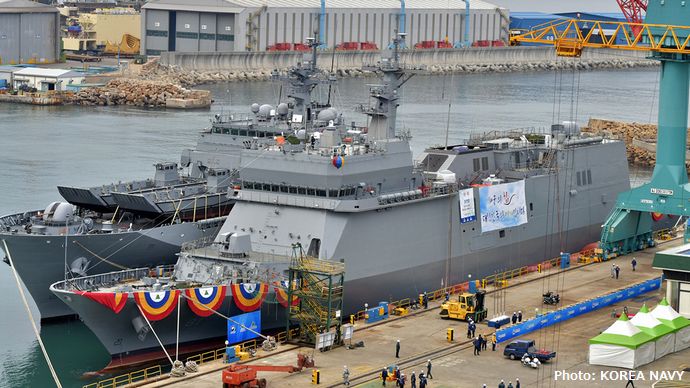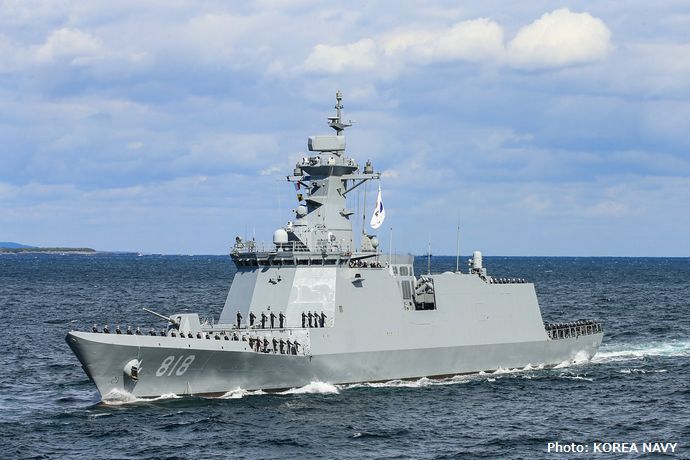South Korea pursuit of nuclear submarines heats up regional competition
11 October 2019
By: Stephen Kuper

South Korea is allegedly reviewing plans to build a 5,000-tonne nuclear-powered submarine based on the French Barracuda Class submarine, which serves as the basis for Australia’s own Attack Class vessels – marking a major transition for the regional power.
As both China and Japan surge ahead with plans to build potent aircraft carrier capabilities, South Korea has joined the race and announced plans to build a modified large-deck aircraft carrier based on the Republic of Korea Navy (ROKN) Dokdo Class amphibious warfare ships – seemingly leaving Australia as the only established Indo-Pacific power without a plan for a traditional, fixed-wing naval aviation and aircraft carrier capability.
Building on this, the growing proliferation of advanced nuclear weapons systems, including the relatively crude, yet still capable submarine launch ballistic missiles recently tested by North Korea, and the increasingly capable nuclear-powered submarine fleets introduced by China and Russia, South Korea has moved to address a tactical and strategic shortfall: a lack of nuclear-powered submarines.
While seemingly a shock move, the South Korean strategic policy institute, the Korea Defense Network (KDN), commissioned a research review into the feasibility of developing an indigenous nuclear-powered attack submarine.
It is reported that the results suggested that South Korea consider building a nuclear-powered attack submarine modelled after the French 5,300-tonne Barracuda Class submarine, the design model for Australia's own fleet of $50 billion Attack Class submarines.
The South Korean predicament
For South Korea, the elephant in the room is the increasingly capable and recalcitrant North Korean regime. Accordingly, the only security measure appears to be a proven submarine-based missile capability would take the North's arsenal to a new level, allowing deployment far beyond the Korean peninsula and a second-strike capability in the event of an attack on its military bases.
North Korea’s own submarine force is burgeoning, as it has developed new conventionally powered subs capable of firing ballistic missiles – while the capability of such platforms remains unknown, they remain potent tactical and strategic factors for South Korean strategic planners.
The North is entering the final stage of development for a 3,000-ton submarine that could carry three SLBMs. The SLBM, called Pukkuksong-1, was reportedly successfully test-fired in mid-2016, and flew about 500 kilometres.
South Korean navy chief Sim Seung-seob told MPs that nuclear-powered submarines capable of longer underwater operations than conventional boats would be "most effective in finding and destroying North Korean submarines equipped with submarine-launched ballistic missiles", according to Yonhap News Agency.
The South Korean military has "recognised [the] necessity and effectiveness" of nuclear-powered vessels, he added.
While South Korea currently operates a robust fleet of conventionally powered submarines, including nine 1,200-ton KSS-I diesel-electric submarines and nine 1,800-ton KSS-II subs, both with technical assistance from German shipbuilding company Howaldtswerke-Deutsche Werft (HDW).
The north Asian nation is on track to build its own 3,000-ton vertical launch system and land-attack cruise missile equipped attack submarine known as KSS-III.
Enter Barracuda
South Korea has a relatively long history of pursuing a nuclear submarine capability, with a clandestine development and building program established in 2003 that was subsequently cancelled when the plan became public and was brought to the attention of the International Atomic Energy Agency challenging non-proliferation treaties.
It is believed that the KDN report favoured the Naval Group designed Barracuda Class nuclear attack submarine as a "realistic" model for the nation to base its nuclear submarine capabilities on.
A large part of this comes as a result of the low-enriched uranium fuelled reactor that powers the Barracuda Class vessels – France recently launched the first of its own submarines, the Suffren, at a ceremony in Cherbourg, attended by Defence Minister Linda Reynolds in July.
Suffren, and its follow-on fleet of six ships worth an expected US$10 billion, is powered by two K15, 150 MW nuclear reactors powering two emergency electric engines and a single pump jet propulsion unit – similar to the unit that has caused contention in Australia's political and strategic community. Designed with a top speed of over 25 knots while submerged, a crew of 60 (with space for up to 12 special operators) and an endurance limited only by food, with nuclear refuelling every 10 years providing virtually unlimited range.
Additionally, the Suffren and its follow-on vessels are designed to be heavily-armed with four 533mm heavy torpedo tubes as well as accommodation for land-attack cruise missiles and mines – this combination of strike capabilities enhances the lethality and combat capabilities of the French Navy at a time when the nation is beginning to expand its influence beyond the Atlantic with renewed focus on the Indo-Pacific.
This South Korean decision comes at a time when debate around Australia's own $50 billion SEA 1000 Attack Class submarine program is undergoing its detailed design phase, which aims to deliver a fleet of regionally-superior submarines at a time when half of the world's combat submarines are expected to be operating in Australia's region.
This decision raises plenty of questions for Australia and Defence Connect will be tracking developments closely.
Your thoughts
Korea's focus on establishing itself as a regional power capable of intervening in regional affairs serves as a model for Australian force structure planners – the comparable economic, political and demographic size of Australia and South Korea combined with the similarity in the platforms and systems operated by both nations serve as a building block for both interoperability and similar force structure models.
As an island nation, Australia is defined by its relationship with the ocean. Maritime power projection and sea control play a pivotal role in securing Australia’s economic and strategic security as a result of the intrinsic connection between the nation and Indo-Pacific Asia’s strategic sea-lines-of-communication in the 21st century.
Further compounding Australia's precarious position is an acceptance that 'Pax Americana', or the post-Second World War 'American Peace', is over and Australia will require a uniquely Australian approach and recognition that the nation is now solely responsible for the security of its national interests with key alliances serving a secondary, complementary role to the broader debate.
Increasingly, multi-domain air power and highly-potent, future-proofed submarine capabilities play an important role in the efficacy of naval forces and serves as a key component in both the force structure and capability development plans for both South Korea and Australia.
These similarities support not only closer relationships between the two nations that share unique geo-political and strategic similarities but also provide the opportunity to develop robust force structures to respond to the rapidly evolving regional strategic environment.
Both fixed-wing naval aviation and amphibious capabilities are one of the key force multipliers reshaping the Indo-Pacific. The growing prevalence of fixed-wing naval aviation forces in particular serves to alter the strategic calculus and balance of power. Get involved with the discussion in the comments section below, or get in touch with
Stephen.Kuper@momentummedia.com.au r at
editor@defenceconnect.com.au.
https://www.defenceconnect.com.au/marit ... ompetition




